Discover 35 hidden attractions, cool sights, and unusual things to do in Verona (Italy). Don't miss out on these must-see attractions: Amphitheater, Museo di Castelvecchio, and Ponte Scaligero. Also, be sure to include Piazza Bra in your itinerary.
Below, you can find the list of the most amazing places you should visit in Verona (Veneto).
Table of Contents
Amphitheater
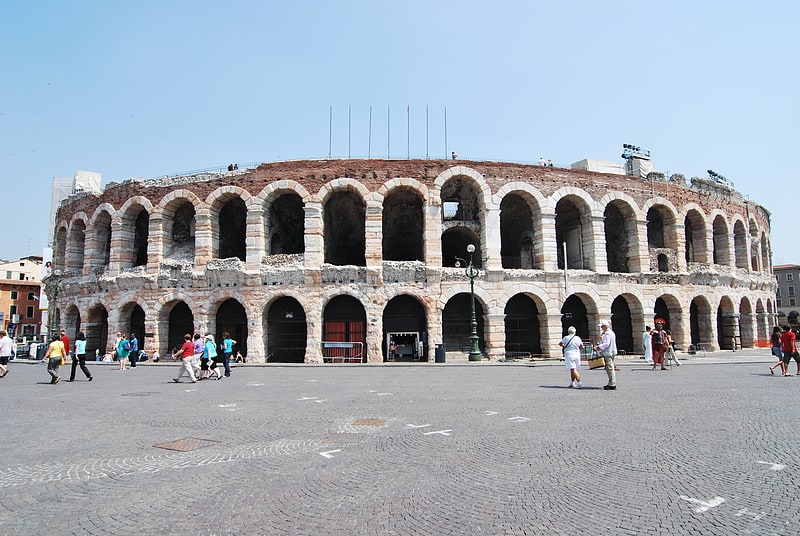
Also known as: Arena di Verona
Roman amphitheater hosting operas. The Verona Arena is a Roman amphitheatre in Piazza Bra in Verona, Italy built in 30 AD. It is still in use today and is internationally famous for the large-scale opera performances given there. It is one of the best preserved ancient structures of its kind. In ancient times, the arena's capacity was nearly 30,000 people. The stage for concerts and opera performances decreases the available places to a maximum of 15,000. It will be used as the Closing ceremony venue for the 2026 Winter Olympics and two weeks later will be used for the Opening Ceremony for the 2026 Winter Paralympics in Milan and Cortina d'Ampezzo.[1]
Address: Piazza Brà, 1, 37121 Verona (Centro Storico)
Museo di Castelvecchio
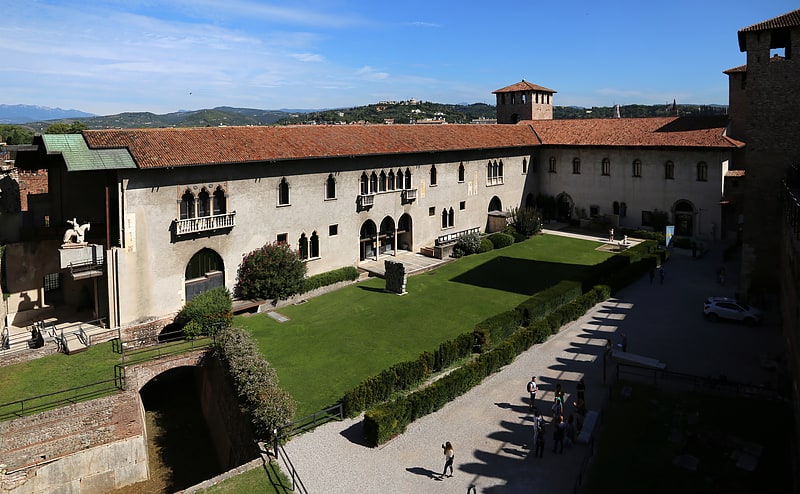
Museum in Verona, Italy. Castelvecchio Museum is a museum in Verona, northern Italy, located in the eponymous medieval castle. Restoration by the architect Carlo Scarpa between 1959 and 1973 has enhanced the appearance of the building and exhibits. Scarpa's architectural style is visible in the details for doorways, staircases, furnishings, and even fixtures designed to hold a specific piece of artwork. The renovation carefully balanced new and old, revealing the history of the original building where appropriate. Unusual at the time, this approach has now become a common approach to renovation.[2]
Address: Corso Castelvecchio, 2, 37121 Verona (Centro Storico)
Ponte Scaligero

Also known as: Ponte di Castelvecchio
Reconstructed 1350s bridge with arches. The Castel Vecchio Bridge or Scaliger Bridge is a fortified bridge in Verona, northern Italy, over the Adige River. The segmental arch bridge featured the world's largest span at the time of its construction.[3]
Address: Corso Castelvecchio 2, 37121 Verona (Centro Storico)
Piazza Bra
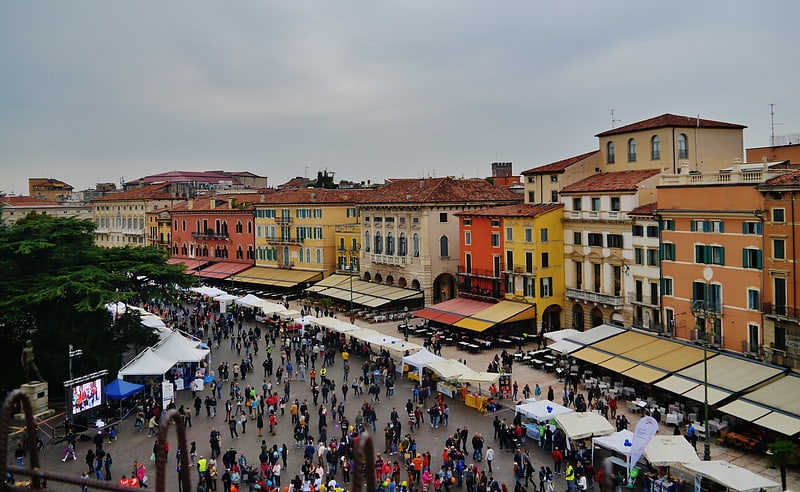
Piazza Bra, often shortened to Bra, is the largest piazza in Verona, Italy, with some claims that it is the largest in the country. The piazza is lined with numerous cafés and restaurants, along with several notable buildings. The Verona Arena, an amphitheatre built nearly 2000 years ago, is now a world-famous music venue with regular operatic and contemporary music performances. Verona's town hall, the Palazzo Barbieri, also looks out across the piazza.[4]
Address: Piazza Bra, 37121 Verona (Centro Storico)
San Nicolò all'Arena

San Nicolò all'Arena is a Roman Catholic parish church in the historic centre of Verona, Italy dedicated to Saint Nicholas. It is located close to the Arena, a well-preserved 1st century AD Roman amphitheatre. The present Baroque building was constructed between 1627 and 1683 on the site of an earlier Romanesque church which had existed since the 12th century or earlier. The church's façade remained incomplete until the neoclassical façade of the church of San Sebastiano was relocated to San Nicolò in the 1950s, after the former church was destroyed during World War II.[5]
Piazza delle Erbe
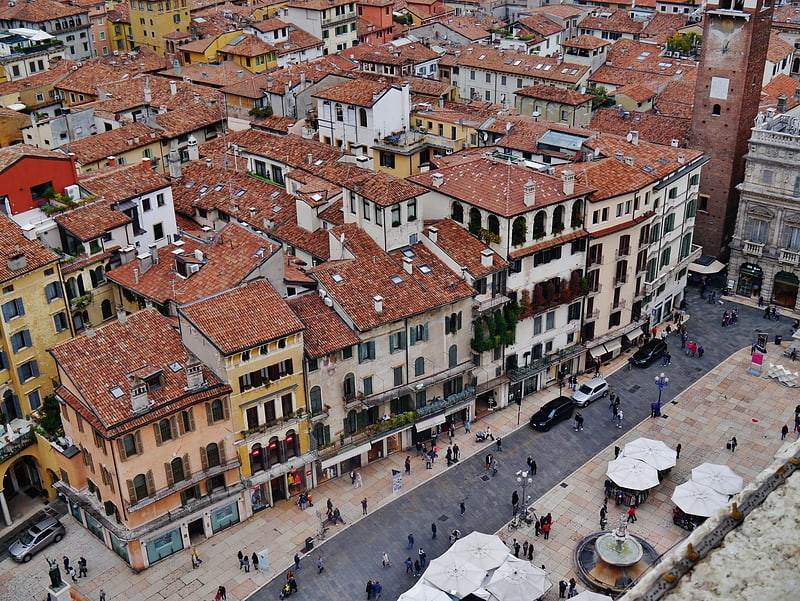
Busy historic city square with eateries. Piazza delle Erbe is a square in Verona, northern Italy. It was once the town's forum during the time of the Roman Empire.[6]
Address: Piazza delle Erbe, 37121 Verona (Centro Storico)
Verona Cathedral
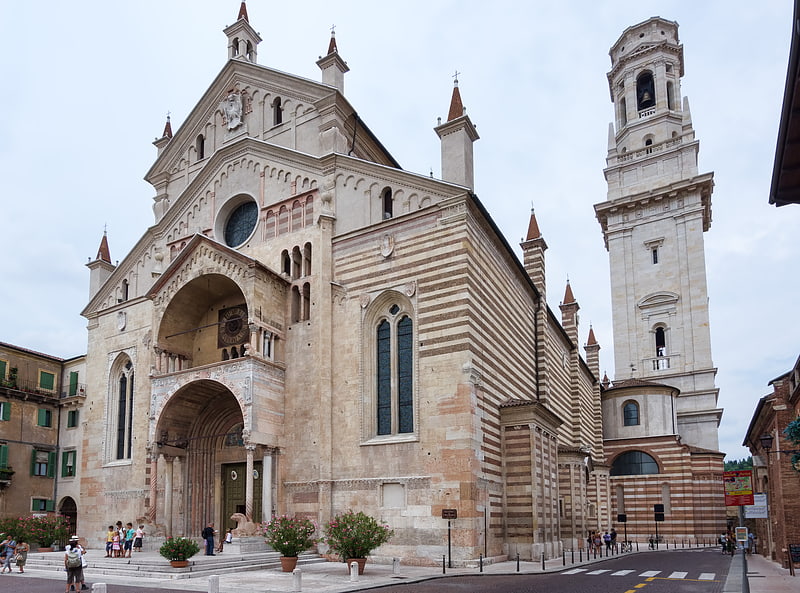
Also known as: Duomo di Verona
Grand cathedral with Titian artwork. Verona Cathedral is a Roman Catholic cathedral in Verona, northern Italy, dedicated to the Blessed Virgin Mary under the designation Santa Maria Matricolare. It is the episcopal seat of the Diocese of Verona.
It was erected after two Palaeo-Christian churches on the same site had been destroyed by an earthquake in 1117. Built in Romanesque style, the cathedral was consecrated on September 13, 1187. The structure was later modified by several renovation interventions, although the plan has remained unchanged.[7]
Address: Piazza Duomo, 4, 37121 Verona (Centro Storico)
Sant'Anastasia
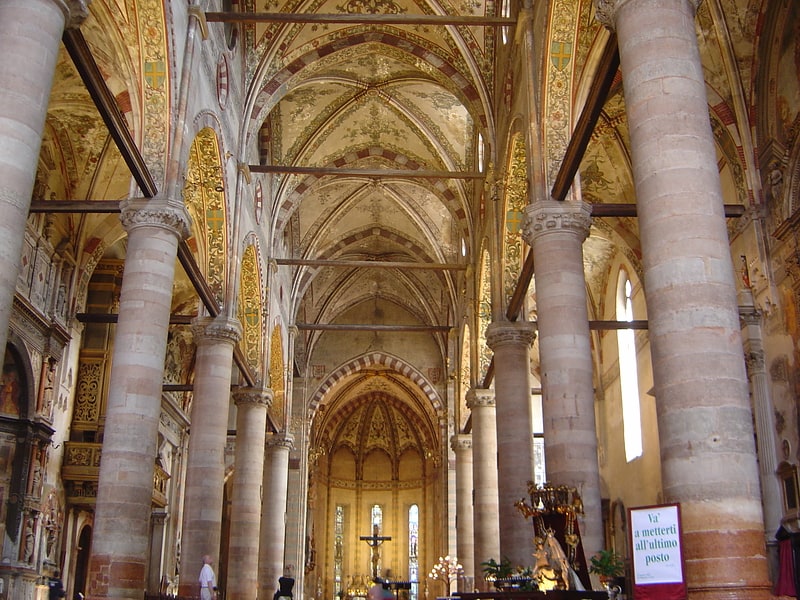
Gothic artworks in a 13th-century church. Sant'Anastasia is a church of the Dominican Order in Verona, northern Italy. In Gothic style, it is located in the most ancient part of the city, near the Ponte Pietra.[8]
Address: Piazza S.Anastasia, 37121 Verona (Centro Storico)
Torre dei Lamberti

Medieval bell-tower and viewpoint. The Torre dei Lamberti is an 84 m high tower in Verona, northern Italy.
Construction of the tower was started in 1172. In May 1403 the top of the tower was struck by lightning, but the restoration works didn't start until 1448 and took 16 years. During that time, the tower was enlarged: The more recent sections can be recognized today by the use of different materials (such as marble). The large clock was added in 1779.
The tower has two bells: the Marangona signals fires, work times, and the hours of the day, while the largest, called Rengo, is used to call the population to arms or to invoke the city's councils.[9]
Address: Piazza dei Signori, 37121 Verona (Centro Storico)
Piazza dei Signori
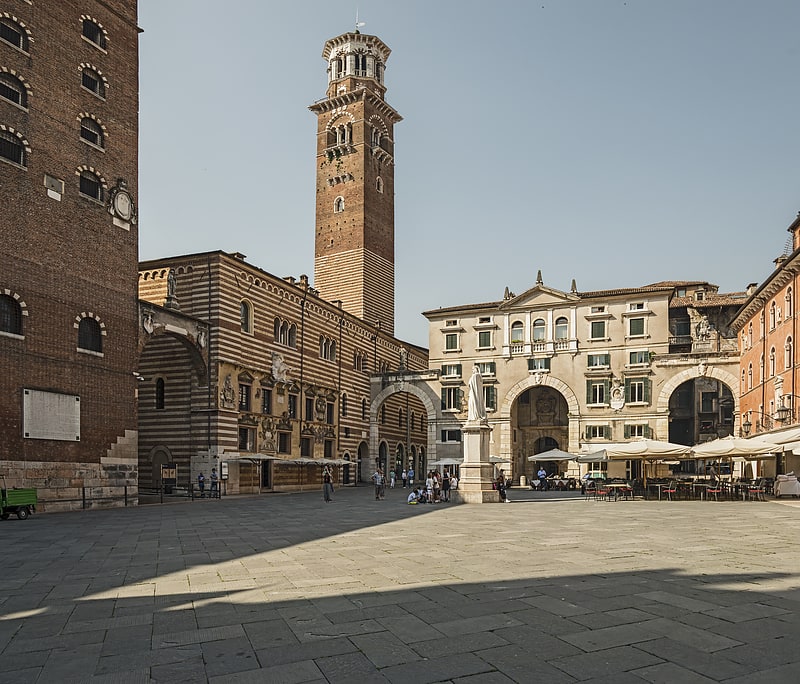
Scenic spot in Verona, Italy. Piazza dei Signori is a city square in Verona, Italy.[10]
Teatro Romano
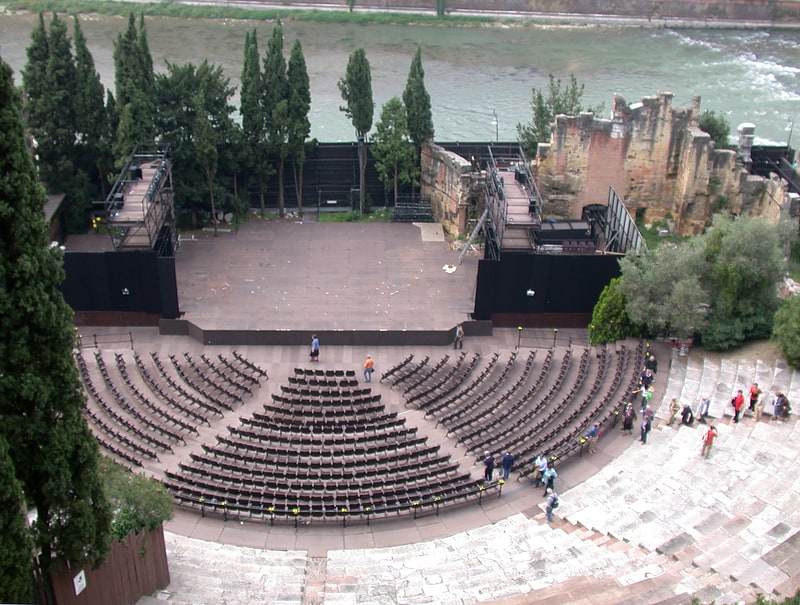
Also known as: Teatro romano di Verona
Theatre in Verona, Italy. The Roman theatre of Verona is an ancient Roman theatre in Verona, northern Italy. It is not to be confused with the Roman amphitheatre known as the Verona Arena.[11]
Address: Rigaste Redentore 2, 37129 Verona (Centro Storico)
Stadio Marcantonio Bentegodi
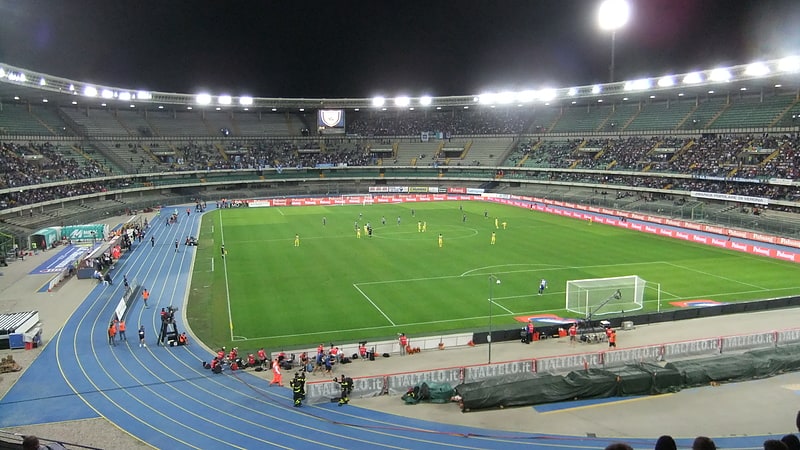
Stadium in Verona, Italy. The Stadio Marcantonio Bentegodi is a stadium in Verona, Italy. It is the home of Hellas Verona of Serie A and was also the home of Chievo Verona until 2021. It also hosts the Women's Champions League matches of Bardolino Verona, some youth team matches, rugby matches, athletics events and occasionally even musical concerts. With 39,211 total seats, of which only 31,045 are approved, it is the eighth-largest stadium in Italy by capacity. The stadium is named after the historic benefactor of Veronese sport, Marcantonio Bentegodi.[12]
Address: Piazzale Olimpia, 2, 37138 Verona (Ovest)
Giardino Giusti
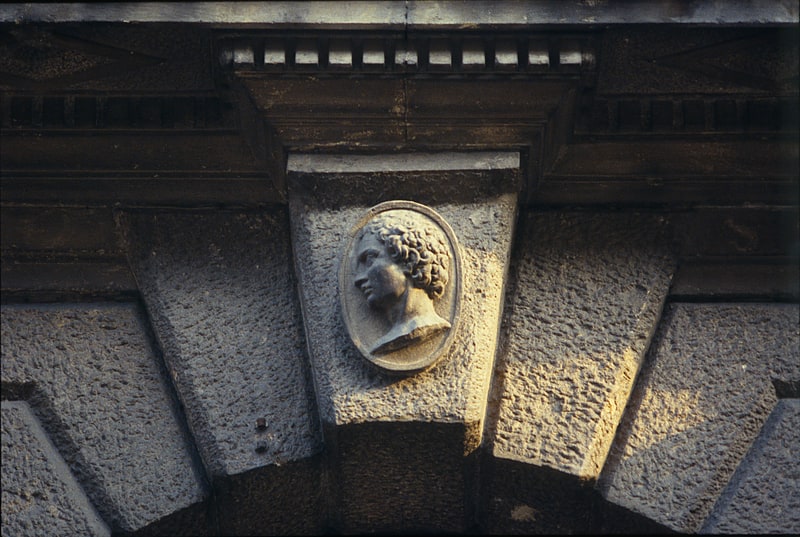
Also known as: Palazzo e giardino Giusti
Palace in Verona, Italy. The Giusti Palace and Garden are located in the east of Verona, Italy, a short distance from Piazza Isolo and near the city centre. The palace was built in the sixteenth century. The garden is considered one of the finest examples of an Italian garden.
The palace is a 16th-century Mannerist structure with a tower added in 1701.
The Italian Renaissance gardens were planted in 1580 and are regarded as some of the most beautiful Renaissance gardens in Europe, a splendid park of terraces climbing upon the hill. They include a parterre and hedge maze, and expansive vistas of the surrounding landscape from the terrace gardens. First, only two square parterres right and left hand of the cypress way were designed, and a maze behind the right one, as figured in Nürnbergische Hesperides in 1714. Some years later, four additional flower parterres were laid out left hand, as to be seen at a map in the Verona State Archives. The booklet, Il paradiso de' Fiori by Francesco Pona informs about the plants used in this time in Giardino Giusti as does also some planting sketches by Pona included in the new edition of this book, Milano 2006. The actual unifying layout of the garden parterres dates from early 20th century. The maze was reconstructed after 1945.
The Giusti family, owner of the palace since the 16th century, was entitled by the Austro-Hungarian Emperor to change its original surname to "Giusti del Giardino" because of the importance of the gardens.
In 2020, the garden was hit by a severe storm, causing severe damage to the plants and killing a lot of the trees, including the 600-year old Goethe cypress. The garden has since this incident been added to Europa Nostra's "7 Most Endangered" list of heritage sites at risk.[13]
Address: Via Giardino Giusti 2, 37129 Verona (Centro Storico)
Arco dei Gavi

Historical landmark in Verona, Italy. The Arco dei Gavi is an ancient structure in Verona, northern Italy. It was built by the gens Gavia, a noble Roman family who had their hometown in Verona, at the beginning of the Via Postumia, the Roman road leading to the city. During the Middle Ages it was used as a gate in the walls.[14]
Address: Corso Cavour, 43, 37121 Verona (Centro Storico)
San Procolo
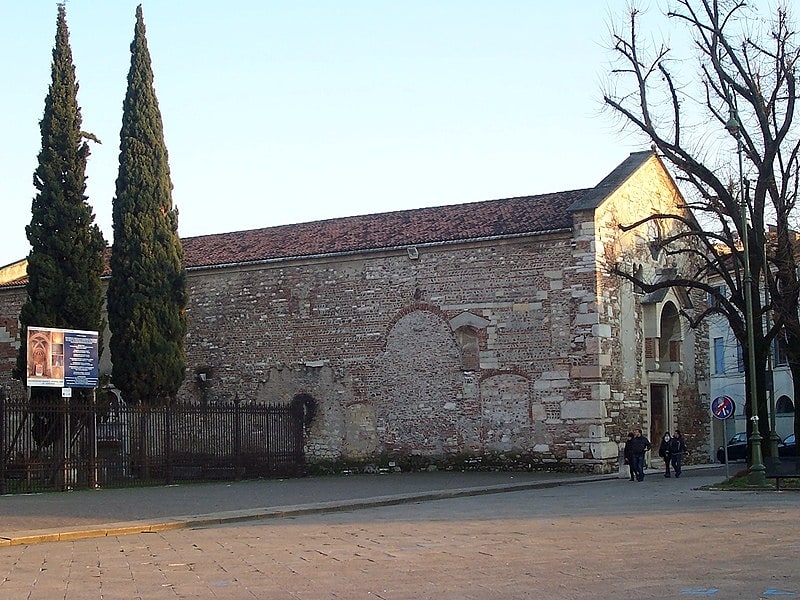
Temple. San Procolo is a Paleo-Christian, Roman Catholic small temple standing adjacent to the Basilica di San Zeno in central Verona, region of Veneto, Italy.[15]
Address: Via San Procolo 1, 37123 Verona (Centro Storico)
Palazzo Canossa

16th-century palace and home to a saint. Palazzo Canossa is a palace in Verona, northern Italy.
It was erected by commission of the Marquises of Canossa to architect Michele Sanmicheli in 1527, not far from the Arco dei Gavi and the Castelvecchio.
Palazzo Canossa is in Mannerist style, with the entrance preceded by a notable portico. One of the ceilings had frescoes by Gian Battista Tiepolo, but they were lost during the bombings of Verona during World War II.
In its history, the palace housed important figures such as tsar Alexander I of Russia, Napoleon Bonaparte and emperor Francis I of Austria.[16]
Address: Corso Cavour, Verona (Centro Storico)
Castelvecchio
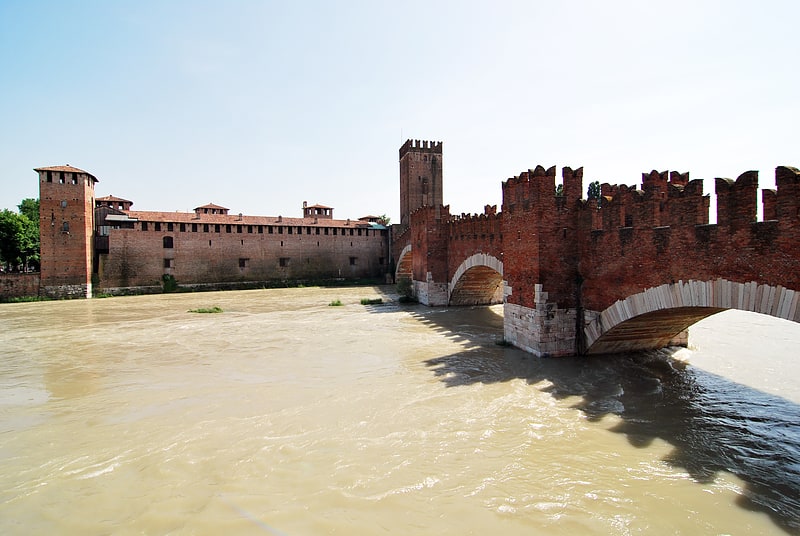
Art/decorative art in medieval castle. Castelvecchio is a castle in Verona, northern Italy. It is the most important military construction of the Scaliger dynasty that ruled the city in the Middle Ages.
The castle is powerful and compact in its size with very little decoration - one square compound built in red bricks, one of the most prominent examples of Gothic architecture of the age, with imposing M-shaped merlons running along the castle and bridge walls. It has seven towers, a superelevated keep (maschio) with four main buildings inside. The castle is surrounded by a ditch, now dry, which was once filled with waters from the nearby Adige.
Castelvecchio is now home to the Castelvecchio Museum and the local officer's club which can be accessed through the left door on Corso Cavour.[17]
Address: Corso Castelvecchio, 21, 37121 Verona (Centro Storico)
Palazzo Barbieri
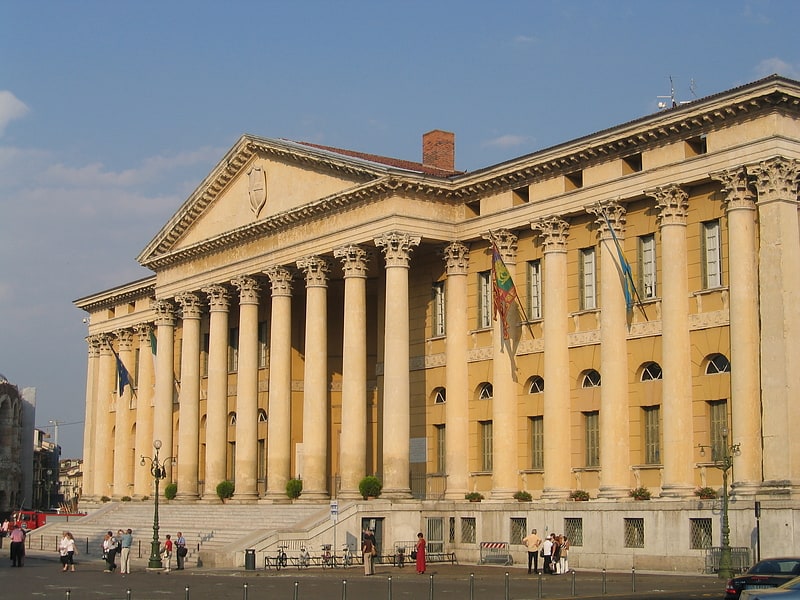
Palazzo Barbieri is a Neoclassical style palace located in Piazza Bra in Central Verona; it now serves as the town hall.
The palace was originally named Palazzo della Gran Guardia Nuova, and housed staff associated with the occupying Austrian Army forces. It was designed by Giuseppe Barbieri and was later named in his honor. Construction began in 1836 and was completed by 1848.
The interiors contain a large canvas (1595) by Felice Brusasorzi depicting the victory of the Veronese over Benacensi in the year 829. Others who worked in the studio or contributed were Alessandro Turchi, Pasquale Ottino, and Sante Creara.
A 14th-century fresco depicting a Crucifixion and the Madonna from a private house was implated into the wall near the entrance. One room has tapestries from the 16th century. One designed by Paolo Farinati depicts the 1164 Victory of the Veronese against Frederick Barbarossa. Tha palace also contains various paintings by Carlo Ferrari and Eugenio Gignous.[18]
Address: Piazza Bra, 37121 Verona (Centro Storico)
Santa Toscana

Catholic church in Verona, Italy. Santa Toscana is a late-Romanesque and early Gothic-style, Roman Catholic church located in central Verona, region of Veneto, Italy.
A church at the site affiliated with the Benedictine order was established in the 11th century, and was adjacent to a cemetery. It was titled then Santo Sepolcro. In 1178 it was linked to the Knights Hospitaller. In 1342, they acquired the relics of Santa Toscana which were placed in an ark atop the main altar. The church was expanded, rebuilt and reconsecrated by 1489. The church suffered bombardment during World War II.[19]
Address: Piazza XVI Ottobre, 27, 37129 Verona (Centro Storico)
Ponte Pietra

Historic, restored Roman arch bridge. The Ponte Pietra, is a Roman arch bridge crossing the Adige River in Verona, Italy. The bridge was completed in 100 BC, and the Via Postumia from Genoa to Aquileia passed over it. It is the oldest bridge in Verona.
It originally flanked another Roman bridge, the Pons Postumius; both structures provided the city (on the right bank) with access to the Roman theatre on the east bank. The arch nearest to the right bank of the Adige was rebuilt in 1298 by Alberto I della Scala. Four arches of the bridge were blown up by retreating German troops in World War II, but rebuilt in 1957 with original materials.[20]
Address: Ponte Pietra 1, 37121 Verona (Centro Storico)
Santo Stefano

Catholic church in Verona, Italy. Santo Stefano is a Paleo-Christian, Roman Catholic basilica church in central Verona, region of Veneto, Italy.[21]
Address: Vicolo Scaletta S. Stefano, 2, 37129 Verona (Centro Storico)
Casa di Giulietta
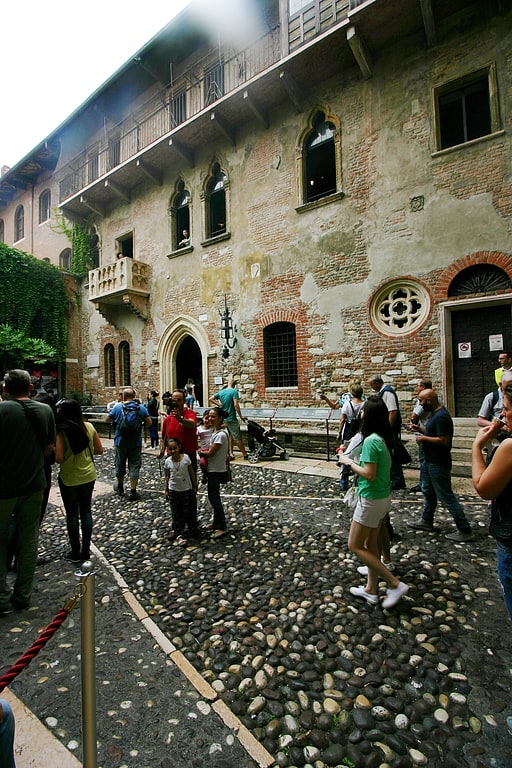
Museum, Architecture, Specialty museum, Historical place
Address: Via Cappello, 23, 37121 Verona (Centro Storico)
San Giorgio in Braida
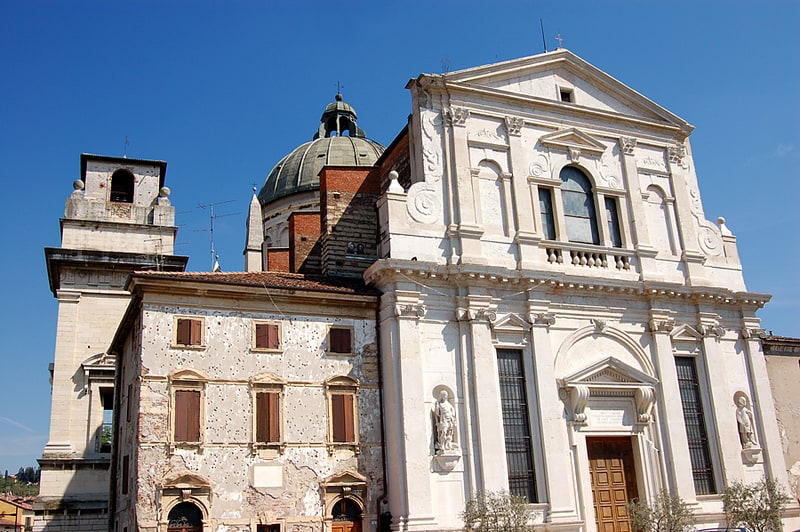
Tourist attraction in Verona, Italy. San Giorgio in Braida is a Roman Catholic church in Verona, region of Veneto, Italy. A church titled San Giacomo in Braida, was located in Cremona, and became superseded by Sant'Agostino.[22]
Address: Piazzetta S. Giorgio, 37129 Verona (Centro Storico)
Basilica di San Zeno
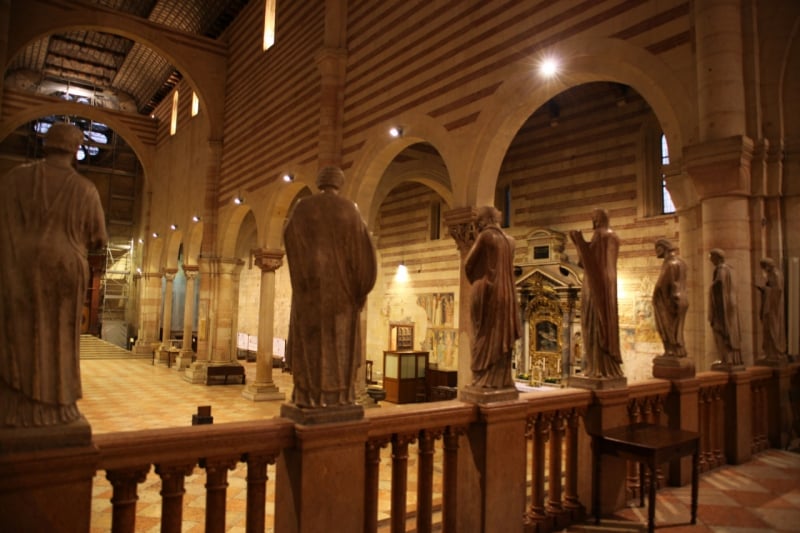
Noted art in striking Romanesque church. The Basilica di San Zeno is a minor basilica of Verona, Northern Italy constructed between 967 and 1398 AD. Its fame rests partly on its Romanesque architecture and partly upon the tradition that its crypt was the place of the marriage of Shakespeare's Romeo and Juliet. It stands adjacent to a Benedictine abbey, both dedicated to St Zeno of Verona.[23]
Address: Piazza San Zeno, 2, 37123 Verona (Centro Storico)
San Giovanni in Foro
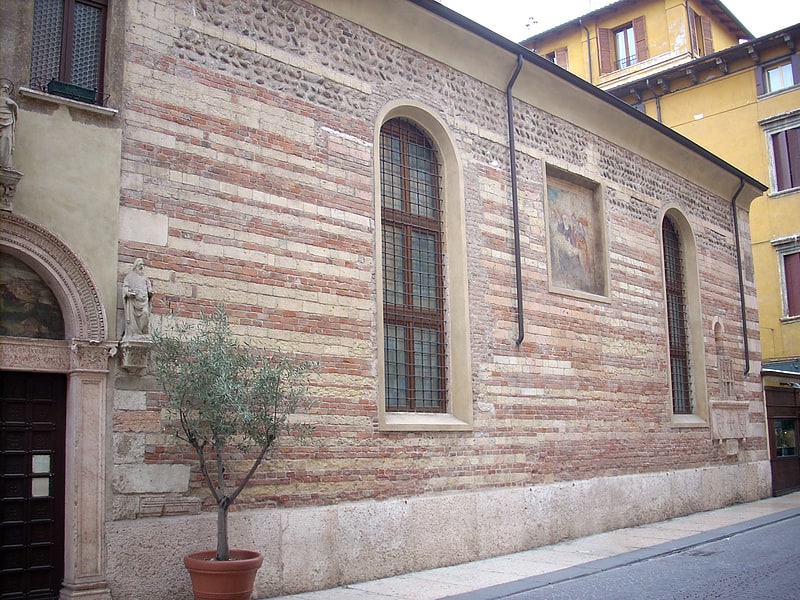
Church in Verona, Italy. The church of San Giovanni in Foro in Verona, is located on Corso Magenta, near the Piazza Erbe, the site of the ancient Roman Forum on Corso Porta Borsari. A church at this site was gravely damaged during the fire that swept medieval Verona in 1172. During restorations in the early 1900s, it was found that Roman walls had been incorporated into the external walls of the church. The base of the bell-tower dates from the 14th century. The renaissance portal of the church was sculpted by Gerolamo Giolfino with statues of Saints John the Evangelist, Peter, and John the Baptist. The fresco in the niche depicting St John was completed by Nicola Giolfino. The 3 baroque bells are rung with the Veronese bellringing art.[24]
Address: Corso Porta Borsari, 20, 37121 Verona (Centro Storico)
Arche Scaligere

Also known as: Arche scaligere
Intricate Gothic funerary monument. The Scaliger Tombs is a group of five Gothic funerary monuments in Verona, Italy, celebrating the Scaliger family, who ruled in Verona from the 13th to the late 14th century.
The tombs are located in a court outside the church of Santa Maria Antica, separated from the street by a wall with iron grilles. Built in Gothic style, they are a series of tombs, mostly freestanding open tabernacle-like structures rising high above the ground, with a sarcophagus surmounted by an elaborate baldachin, topped by a statue of the deceased, mounted and wearing armour. According to the French historian Georges Duby, they are one of the most outstanding examples of Gothic art.[25]
Address: Via Santa Maria Antica, 2, 37121 Verona (Centro Storico)
San Matteo Church
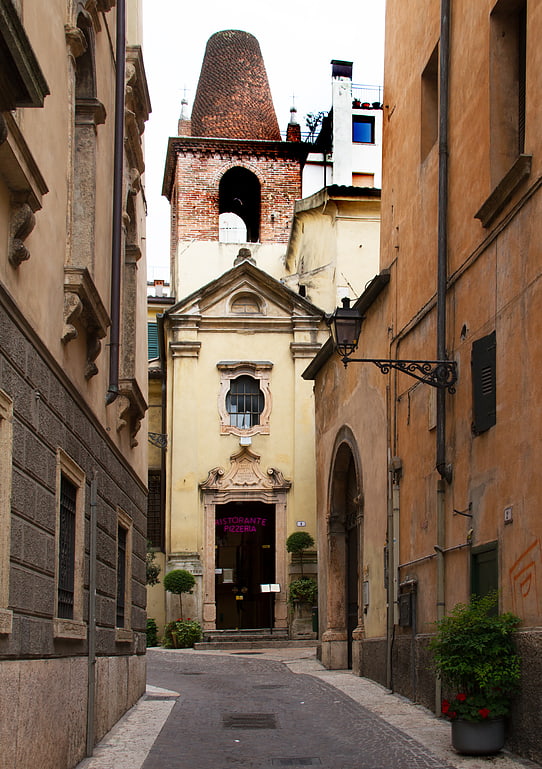
San Matteo con Cortile is a former Roman Catholic church in the historic centre of Verona, Italy dedicated to Matthew the Apostle. It was constructed in the medieval period on the site of a Roman temple of Janus. The building was deconsecrated in 1806 and it was used for various purposes, and it currently houses a restaurant and pizzeria.[26]
Address: 4 Vicolo San Matteo, Verona (Centro Storico)
Porta Leoni
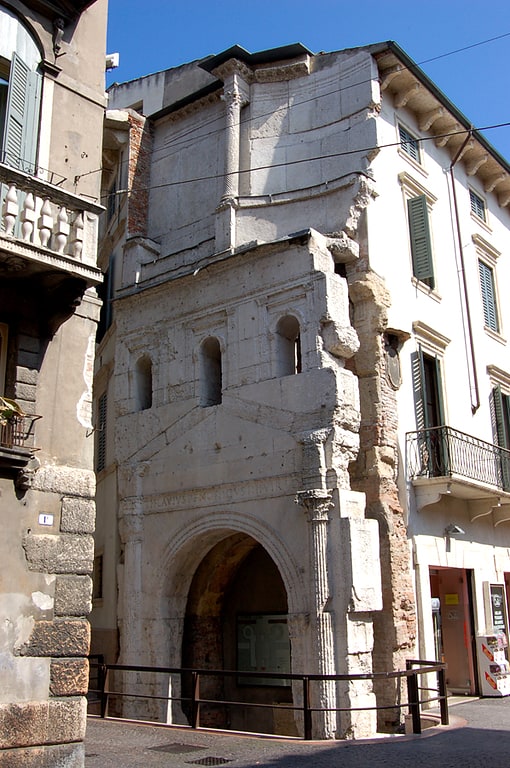
Historical landmark in Verona, Italy. Porta Leoni is an ancient Roman gate in Verona, northern Italy.
The gate was built during the Roman Republic by P. Valerius, Q. Caecilius, Q. Servilius and P. Cornelius, and restructured in imperial times. It was connected to the road which led to Bologna and Aquileia.
The original Roman name is unknown. During the Middle Ages it was called Porta San Fermo, due to the nearby church, while in the Renaissance it was known as Arco di Valerio. The current name derives from a Roman tomb decorated with two lions (Italian: leoni), now moved near Ponte Navi.
The gate has a square structures, with a double façade and two towers which looked towards the countryside. Now only half of the inner façade, covered with white stone in the imperial age, and the foundings are visible. The original decorations are all lost. The lower part is similar to that of Porta Borsari (also in Verona), while the upper part has an exedra with twisted columns.[27]
Address: Via Cappello, 37121 Verona (Centro Storico)
Chiesa di San Fermo Maggiore
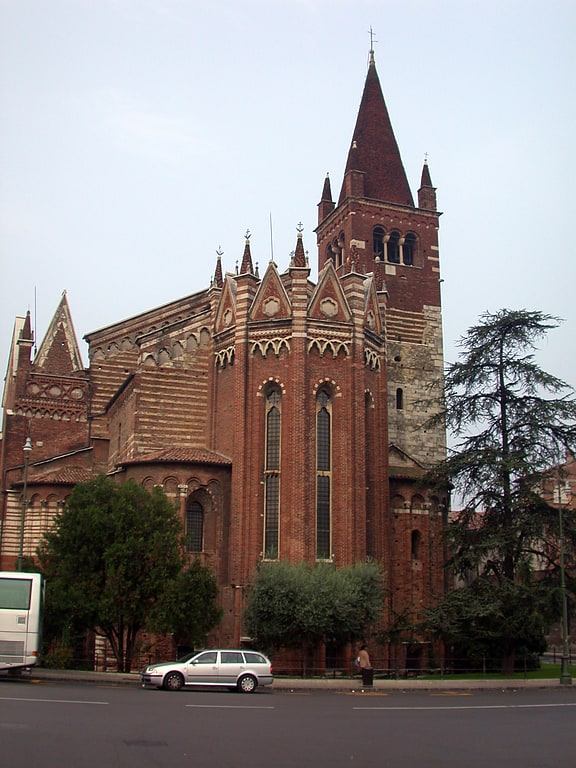
Catholic church in Verona, Italy. San Fermo Maggiore is a church built in Romanesque style in central Verona.[28]
Address: Via Dogana, 2, 37121 Verona (Centro Storico)
Porta Borsari
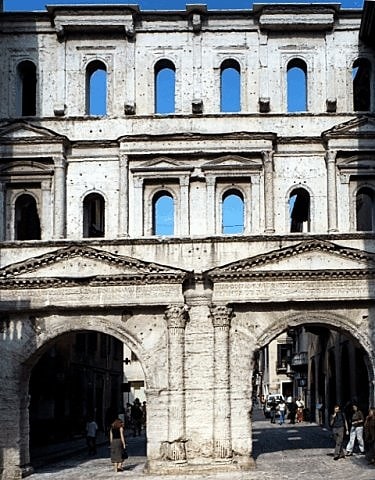
Ancient, arched entrance to the city. Porta Borsari is an ancient Roman gate in Verona, northern Italy.
It dates to the 1st century AD, though it was most likely built over a pre-existing gate from the 1st century BC. An inscription dating from emperor Gallienus' reign reports another reconstruction in 265 AD. The Via Postumia (which here became the decumanus maximus) passed through the gate, which was the city's main entrance and was therefore richly decorated. It also originally had an inner court, now disappeared.
The gate's Roman name was Porta Iovia, as it was located near a small temple dedicated to Jupiter lustralis. In the Middle Ages it was called Porta di San Zeno, while the current name derives from the guard soldiers which were paid the dazio (Latin bursarii).
The façade, in local white limestone, has two arches flanked by semi-columns with Corinthian capitals which supports entablature and pediment. In the upper part is a two-floor wall with twelve arched windows, some of which are included in small niches with triangular pediment.[29]
Address: Corso Porta Borsari, 37121 Verona (Centro Storico)
San Lorenzo
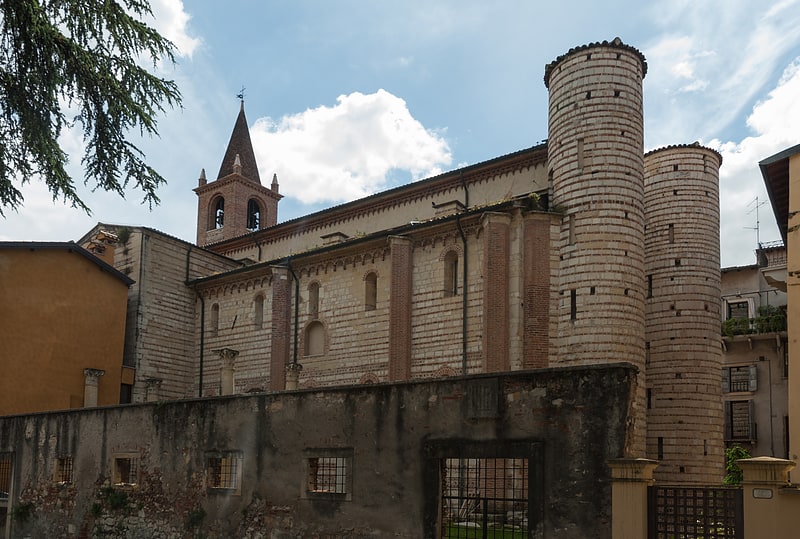
Basilica in Verona, Italy. San Lorenzo is a Romanesque style, Roman Catholic church on Corso Cavour in central Verona, region of Veneto, Italy.[30]
Address: Corso Cavour, 28, 37121 Verona (Centro Storico)
Palazzo Maffei
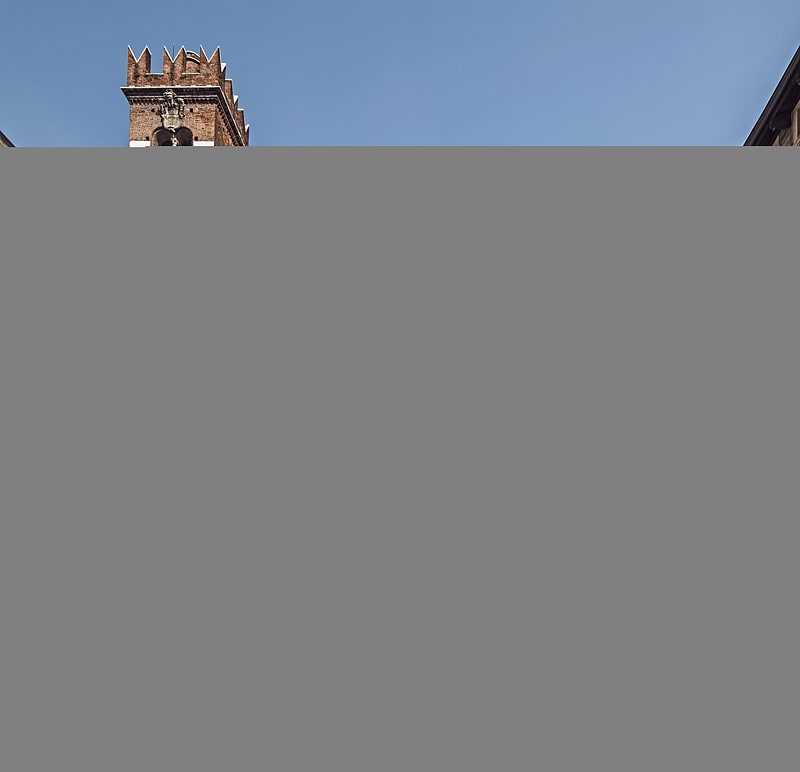
Palace in Verona, Italy. Palazzo Maffei is a historical palace in Verona, northern Italy, on the north-western side of Piazza delle Erbe.[31]
Address: Piazza delle Erbe 38, 37121 Verona (Centro Storico)
Santa Maria di Chiavica

Santa Maria in Chiavica is a former Roman Catholic church, now deconsecrated, in the Renaissance style, located on Via S. Maria in Chiavica number 7 in central Verona, region of Veneto, Italy. The building retains portions of its original Romanesque structure and original fresco and altar decoration, but is now used for theatrical and musical performances.[32]
Santuario di Santa Teresa di Gesù Bambino

Church in Verona, Italy. The Shrine of St Therese of the Child Jesus is a place of Catholic worship in Verona. Located in the southern outskirts of the city, in the Borgo Roma District, entrusted to the Discalced Carmelites. Construction began in 1901, was completed in 1904 and the church was consecrated the following year.
The first stone was laid on 29 July 1901 and the project was completed in 1904. On 15 January 1905, the bishop of Verona Cardinal Bartolomeo Bacilieri inaugurated and blessed the church, originally dedicated to the Holy Family. Pope Pius XI raised it to the rank of minor basilica in 1938.[33]
Address: Via Volturno 1, 37135 Verona (Sud)
Chiesa di Santa Maria Antica
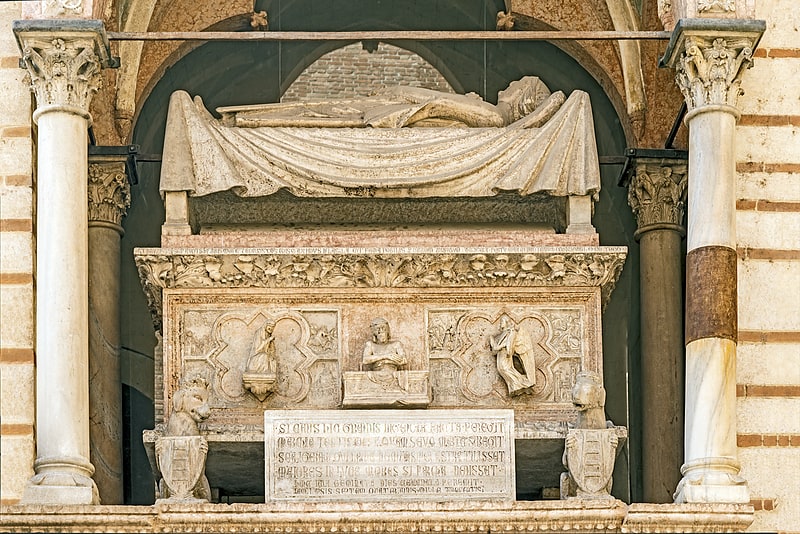
Church in Verona, Italy. Santa Maria Antica is a Roman Catholic church in Verona, Italy. The current church is Romanesque in style and dates to 1185, rebuilt after the earthquake of 1117 destroyed the original building that dated back to the end of the period of Lombard domination in the 7th century. The only surviving remains of the 7th-century building is a fragment of black and white mosaic floor.
The current building was dedicated by the patriarch of Aquileia and acted as the private chapel of Verona's ruling Scaligeri family, located beside their family cemetery (the site of the 13th-century Scaliger Tombs). The church has a small tuff bell tower (with three baroque bells) in a purely Romanesque style, with mullioned windows and a brick-covered spire. Around 1630 the three-nave interior was altered to the Baroque style, though a restoration at the end of the 19th century restored the original Romanesque interior, divided by columns with "sesto rialzato" arches, and with an "incavallature" roof supported by transverse arches, as at the basilica of San Zeno. There are two lateral apses in tuff and cotto, and a central apse with two early 14th-century frescoes.
The exterior has alternate bands of tuff and cotto, with small windows. The side-door is dominated by the arch of Cangrande I della Scala, the soberest but most monumental of the family arches. Excavations have found a cemetery near the church, containing fifty 11th-century burials, some aligned north-south, some east-west.
The belltower contains two bells cast during the 17th century and rung in the Veronese syle.[34]
Address: Via Arche Scaligere, 3, 37121 Verona (Centro Storico)